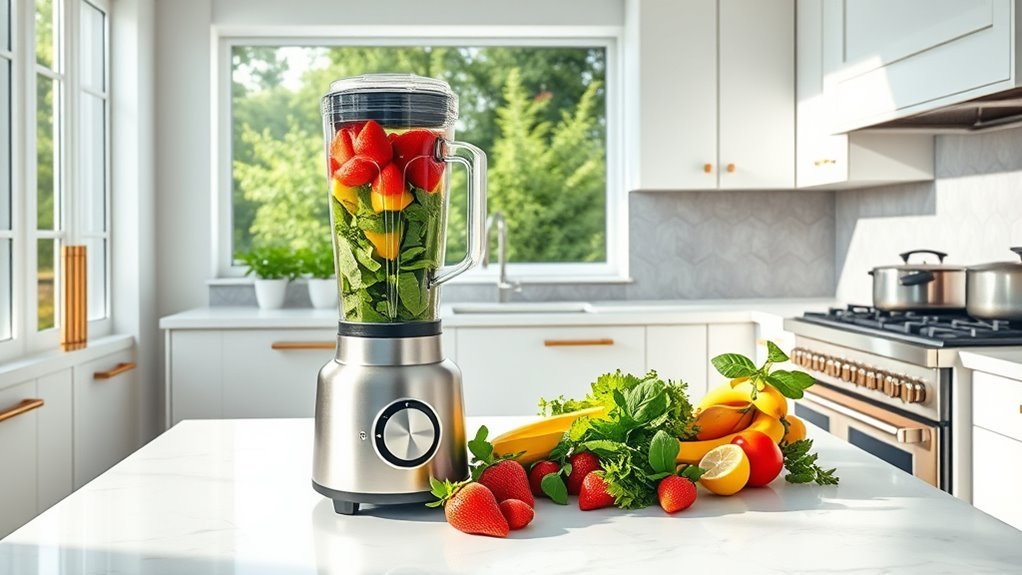Blender noise poses five serious threats to our hearing health. First, exposure to 85-100 dB can cause immediate damage to inner ear hair cells. Second, regular blending sessions may trigger temporary muffled hearing or tinnitus. Third, daily use without protection risks permanent hearing loss. Fourth, noise damage accumulates over time, even from short sessions. Fifth, standing too close amplifies these risks. Let’s explore how to protect ourselves while still enjoying our favorite smoothies.
Understanding Decibel Levels of Kitchen Blenders

While many of us don’t think twice about firing up our blenders for a morning smoothie, these kitchen workhorses pack a serious auditory punch.
Standard kitchen blenders operate at decibel levels between 85 and 100 dB – that’s enough to trigger noise-induced hearing loss with prolonged exposure.
Let’s get real about hearing damage: The CDC warns that blender noise at 90 dB can harm your hearing in under an hour.
We’re not just talking about temporary discomfort – we’re facing potential cumulative hearing damage from regular use.
Your morning smoothie routine might be compromising your hearing health more than you think.
When it comes to sound exposure, prevention beats treatment every time.
If you’re blending frequently, especially at high speeds, don’t skip the ear protection.
Your future self will thank you.
Immediate Effects of High-Intensity Blender Operation
When you hit that blender button, you’re releasing more than just blade-spinning fury – you’re creating an acoustic assault on your ears.
Let’s break down what happens the moment you expose yourself to that high-volume kitchen cacophony.
- Your inner ear’s delicate hair cells take an immediate hit from the intense vibrations.
- Exposure to loud noises above 90 dB starts damaging hearing in under an hour.
- You might notice muffled sounds or trouble understanding speech right after blending.
- That annoying ringing (tinnitus) isn’t just irritating – it’s a warning sign.
- Without protection, every high-intensity blend chips away at your hearing health.
These immediate effects aren’t just temporary inconveniences – they’re red flags for potential permanent damage.
We’re talking about real hearing loss that sneaks up on you, one smoothie at a time.
Long-Term Consequences of Regular Blender Use

Since daily blending might seem harmless, you’d never guess it’s slowly destroying your hearing.
We’re talking noise levels of 90-95 decibels (dB) – enough to trigger permanent hearing loss in under an hour.
Here’s the kicker: prolonged exposure to your trusty blender damages those delicate inner ear cells.
And once they’re gone, they’re gone for good.
We’re seeing more users develop tinnitus (that annoying ear ringing) from regular blending, a classic red flag for auditory health problems.
Don’t panic – we’ve got solutions.
Wearing hearing protection like earplugs or earmuffs while blending can dramatically reduce your risk.
It’s a simple fix for a serious problem.
Trust us, your future self will thank you for protecting those ears now.
Safe Distance and Duration Guidelines
Because your ears can’t tell you when they’re hitting their limit, you’ll need precise guidelines for safe blending.
We’ve distilled the essential rules to protect your hearing health when using these kitchen powerhouses.
- Maintain a safe distance of 3-4 feet from your blender to reduce noise exposure
- Limit blending sessions to under 30 minutes – those 90-95 dB levels aren’t playing around
- Install sound-absorbing materials like rugs or curtains in your blending space
- Monitor duration closely – every 3-dB increase above 85 dB cuts your safe listening time in half
- Take strategic breaks between blending sessions to let your ears recover
Hearing Protection Strategies for Daily Blending

As your daily blending habits put your hearing at risk, you’ll need a robust protection strategy to avoid permanent damage.
Let’s tackle this head-on: foam earplugs are your first line of defense, capable of reducing noise levels by up to 33 dB. That’s essential when you’re facing 90-100 dB of blender noise.
We recommend investing in quieter models specifically designed to minimize NIHL risk. While they’re pricier, your hearing’s worth it.
Meanwhile, master the art of strategic blending: take breaks between sessions, limit exposure time to under 30 minutes, and position your blender on stable surfaces to reduce vibrations.
Frequently Asked Questions
Can Blenders Damage Hearing?
We’d love thinking our smoothie makers are harmless, but blender volume and sound intensity aren’t. Without hearing protection, those high noise levels can cause ear damage and hearing loss through long-term exposure.
What Sounds Can Damage Your Hearing?
We can damage our hearing from prolonged exposure to loud environments like industrial noise, high music volume, and sounds above 85 decibels, causing acoustic trauma, tinnitus risks, and age-related loss.
How Does Noise Exposure Affect Hearing?
Like a battering ram, noise induced hearing damage breaks down our auditory health over time. Long term exposure to high sound levels and environmental noise can permanently raise hearing thresholds without proper protection.
What Are Symptoms of Noise-Related Hearing Damage?
We’ll notice signs like tinnitus (ringing ears), muffled conversations, difficulty with soft sounds, and temporary hearing loss. Long-term exposure can lead to permanent damage and ongoing sound sensitivity issues.

